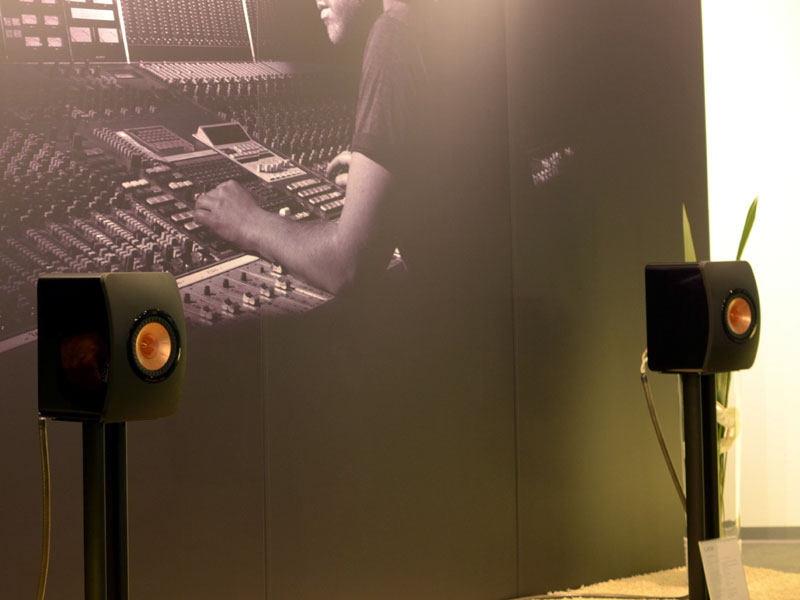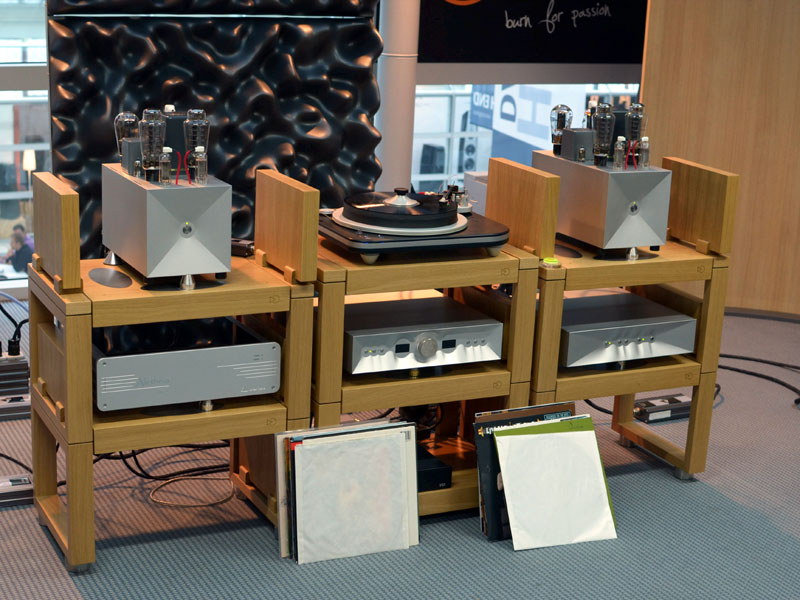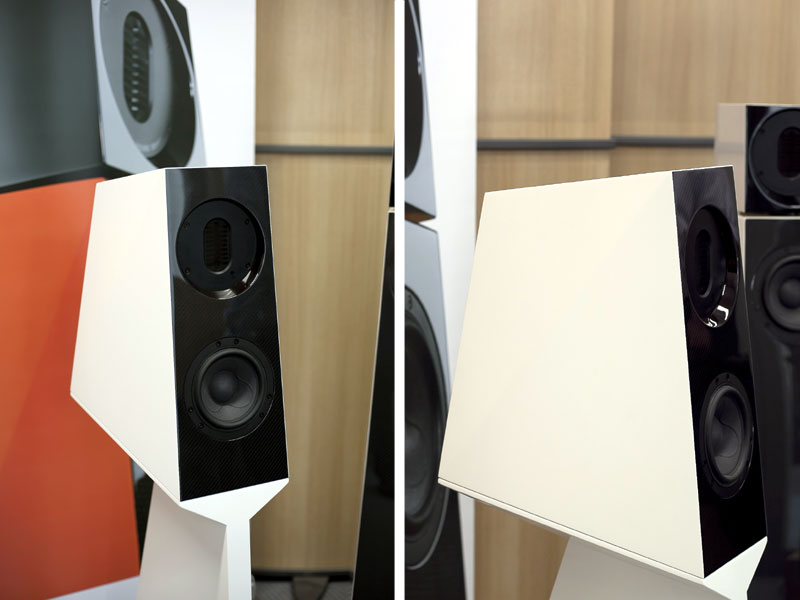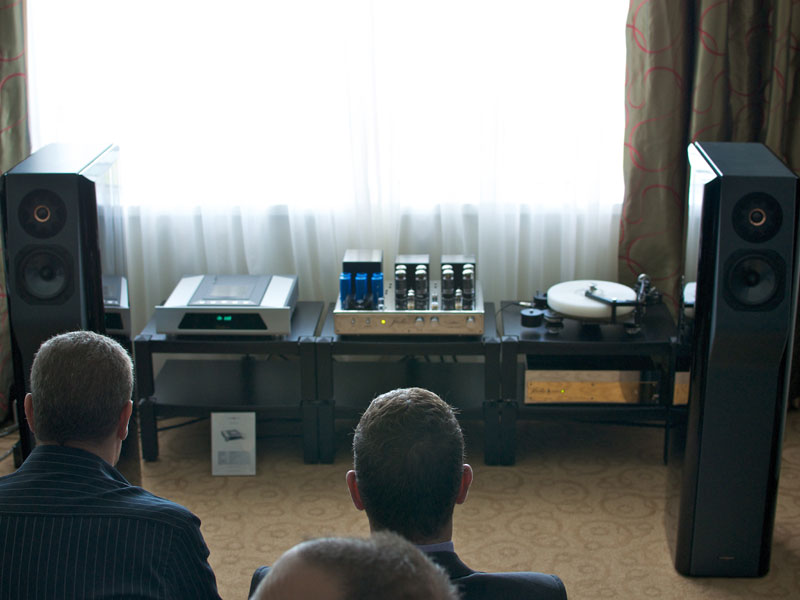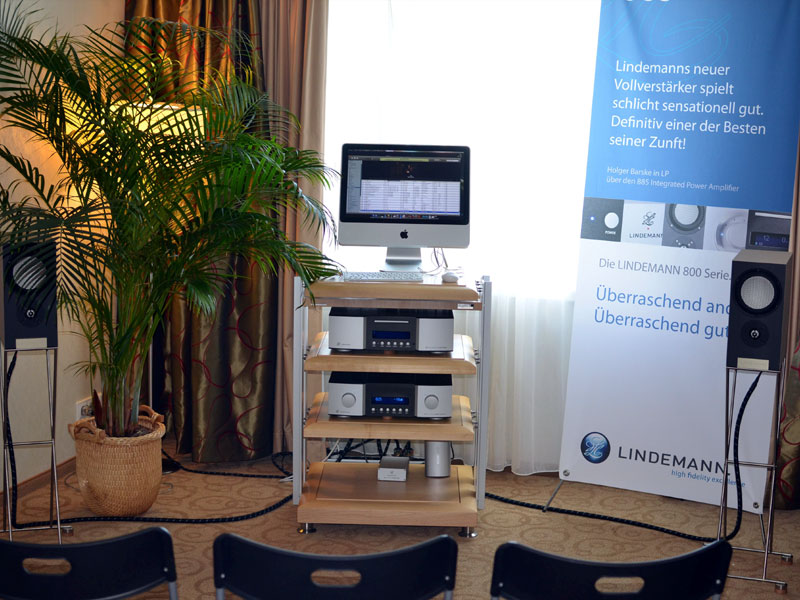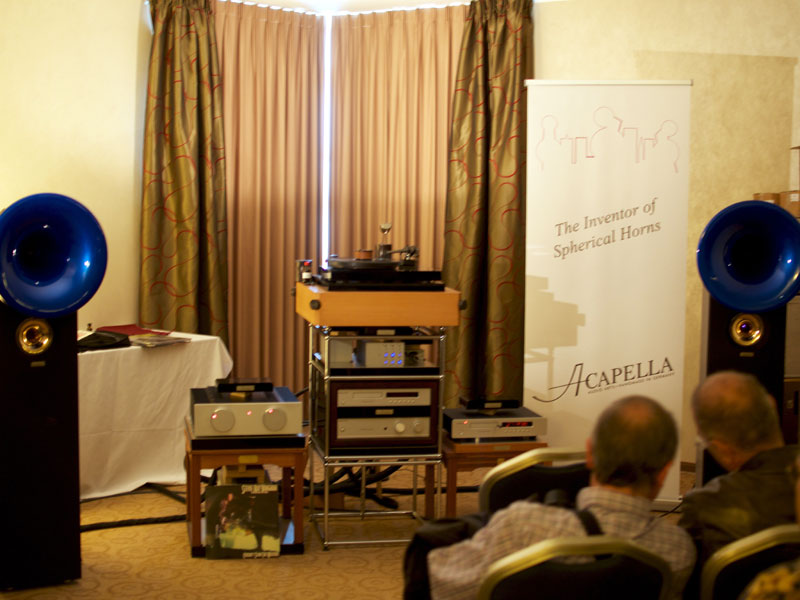High End 2012 • A Treat For the Ears
Having spent some time discussing the problematic acoustics and structural vagaries of the MOC in the first part of this report, it’s time to buckle down and recognize those exhibitors who overcame the (considerable) obstacles -- either through sheer grit, skill, perseverance, dumb luck and determination, or by simply decamping to the HiFi Deluxe parallel show at the Marriott.
First, a special mention goes to KEF, who launched a 50th Anniversary product, the unimaginatively named LS50 compact stand-mount. The title derives from the half-century the company has existed and its central role in the development of the BBC LS3/5a -- to which the new speaker is offered in homage. An immaculately lacquered and carefully contoured cabinet mounts a single 130mm (5 1/8") Uni-Q coincident driver dead center on its baffle, the anodized copper coloring of the drive unit contrasting sharply with the mirror black finish of the rest of the enclosure. The complex ribbing on the cone, its Mg-AL alloy and the tangerine waveguide and aluminum alloy used for the tweeter suggest a heavy dose of the technology developed for the Blade, but the real innovation in the LS50 is hidden inside and round the back. Internally, the bracing is spaced from the cabinet by constrained layers, adding a damping as well as stiffening effect. Constrained layers have been used in speaker cabinets before (just see the Lindemann BL-10 review), but their use between brace and wall is a new one on me, promising a significantly more economical application of the technique, both by limiting the amount of material required and by placing it where it’s really needed. The other big development is the use of an elliptical port with flexible walls. These are designed to allow midrange energy that has entered the port to escape, reducing longitudinal resonances within the port itself and coloration levels as a result. The carefully flared mouth prevents chuffing, and the port exit is rear facing to prevent its interfering with the incredibly phase- and dispersion-coherent output of the Uni-Q driver. That’s a lot of technology packed into an immaculately presented little speaker. But the best news is the price; at £800 a pair, the LS50 is only just above budget speakers in terms of cost. An even bigger surprise was the open, relaxed, confident and engaging sound it was making. Being driven by a MacBook Pro, running J-River through an Arcam D38 DAC and A38 integrated amp, the little speaker made music with an easy confidence and a sense of scale that belied both its size and price. Without making any allowances for either, I’d say that this was the second-best sound I heard at the MOC, which, given the fact that it was surrounded on all sides by systems getting awfully close to seven-figure asking prices, is either impressive or depressing depending on your point of view. The large space, distance from walls and limited output at really low frequencies obviously helped, but this was a system I could quite happily have listened to and enjoyed long-term -- and doing it on day one of the show. By the end of the event it was sounding even better. Make no mistake -- this is no charity prize, given to the kid running in the adult race. The LS50 deserves the award based entirely on its merits. Its success also tells us three things:
If you can’t make show rooms work, are you really going to do that much better in a customer’s home? The rooms at the MOC might be bad, but you can get good results out of them -- if you approach the problem in the right way. What amazes me is how many exhibitors simply forged ahead regardless, and I’m forced to wonder how many even recognized the sonic catastrophe that resulted. When an £800 speaker and a set of mid-priced electronics are showing them how it’s done, the answer has to be "Not many." As if to really ram that point home, the best sound at the MOC was to be found in the Leading Edge room. A cooperative venture between UK-based Vertex AQ and the German loudspeaker manufacturer and architectural acoustics company Kaiser, Leading Edge offer a complete range of mechanically coupled supports and room acoustic treatments. Assuming their products actually do what it says on the tin, who should be better placed to tackle the MOC’s nightmare acoustic environment? Not making the task any easier, their system was set up in one of the top-floor rooms, which suffer the biggest problems, making the results achieved all the more impressive.
How did they do it? The system itself was all good stuff: digital front-end was a PC acting as a file server, using J-play 4.2 software and a Human Audio Tabla USB-to-S/PDIF converter ($995) to feed a Vertex Aletheia DAC (£11,500). The turntable was a Spiral Groove SG2 with Centroid 'arm carrying an Air Tight PC-3 cartridge. Amplification was courtesy of Thrax: their Orpheus phono stage (€15,000), Dionysos line stage (€15,000) and Spartacus parallel single-ended-triode monoblocks (€36,000). Speakers, not surprisingly, were Kaiser’s own, either the Kawero or the new, stand-mounted Chiara, the latter being in use on the several occasions that we were listening. But the real reason for the system’s success lies in the supports, cabling and acoustic treatments that allowed the equipment to show what it was capable of. The most obvious elements were the large D-panels and the funky Spline Diffusers (shown above behind the rack) used to calm the room’s lively acoustic. The diffusers will be familiar in concept to anybody who has seen RPG Skylines or similar disruptive/random reflectors, although Kaiser claim significantly more sophisticated mathematics behind their three-dimensional form. Certainly, simply standing in front of them and clapping demonstrated just how effective they are. The larger, freestanding D-panels are also much more sophisticated than they seem. Unlike most acoustic treatments, they work in the velocity domain rather than by absorbing pressure variations. With a full review pending, I’ll skip the finer details, but experience at home has demonstrated just how effective they are. Interestingly, Fono Acustica also used the D-panels in their room, to similarly positive effect. In a permanent installation the panels can be wall- or even ceiling-mounted, making them a very practical solution in a domestic environment. Far less obvious was the contribution of the Leading Edge racks. This modular support system uses a cascade approach to isolating the signal, both by draining unwanted energy from the equipment itself and decoupling the support shelves from the outside world. The shelves themselves contain acoustic absorption to dissipate the energy fed into them via the dedicated couplers. They also have RFI-absorbent material, and they utilize the same micro-perforated undersurface that you see on the D-panels. They are, in effect, more capable and far more attractive versions of the old Vertex Kinibalu support platforms, but incorporating a stacking capability and individual leveling for each shelf. Additional mini D-panels can be added to the sides of the rack to further inhibit airborne energy from both reaching the equipment and spreading within the room itself. Again, these impressive components are in-house at present. Cabling throughout the system was Vertex AQ, and this included considerable treatment of mains-borne mechanical energy and RFI.
The end result was a system that was allowed to really sing. The Chiara speakers contain a lot of hidden technology, including a rear-facing ABR and a sophisticated acoustic matrix in their stand that helps account for the lack of audible cabinet effects in their sound. As soon as the music started, the speakers simply disappeared. Weight and scale were both exceptional for the size and €15,000-per-pair price, with a real sense of presence and dimensionality. Music breathed convincingly, tonality was natural and dynamics impressively unforced and lively. In short, this system was doing everything a good system should. It was getting out of the way of the music, allowing me to enjoy the performance without drawing attention to itself -- and it was doing it to a standard that easily exceeds many a really expensive home setup. To achieve that level of coherent, natural and convincing musical communication is impressive under any circumstances; to do it in the attic of the MOC must seem close to miraculous to many of Leading Edge's competitors -- if they even took notice. Yet this sonic splendor was simply the product of a systematic, all-embracing approach to those issues that impact the operating conditions of any system. As the saying goes, "It’s not rocket science." Once you’ve experienced what Leading Edge has achieved, the results witnessed over at the Marriott should come as no surprise. Why? Because all of the better-sounding rooms at HiFi Deluxe shared this holistic, systematic approach to setup.
Audioplan were running a set of their larger floorstanders, the Konzert III, driven by a Jadis DA88S integrated and Orphee CD player. The turntable was a Townshend Rock 7 with Excalibur 'arm and a ZYX 4D cartridge. Where’s the continuity there? Well, if anybody can take the credit for creating the concept of a coherent cable loom, it’s Audioplan. Their cable range contained dedicated source and digital cables, power cables, distribution and a modular filtering solution more than 25 years ago -- and it’s still the same today. Back then they were distributing Lovan racks, Sicomin accessories and the Jadis electronics, so the brands represented in the system on show have had nearly three decades to bed in and get cozy -- and it showed. The Audioplan speakers have always had a sense of rightness about their musical presentation, a quality that lets you simply forget the speaker and enjoy the music. The Konzert III is no exception, and if its prodigious bass capabilities could overwhelm the small room, in every other respect the sound was warm, open, inviting and natural, with a real sense of get-up-and-go. Much of that will be down to the DA88S, an amp whose musical enthusiasm knows few if any bounds, but the system here was clearly working as a whole. Almost next door, Lindemann had two rooms showing their smallest system and one from further up the range. Chris Thomas has just reviewed the Lindemann BL-10 speaker (€7000 per pair including stands), and it sounded just as glorious, uncluttered and informative here as it does in his home system. Running from an iMac feeding the 825 CD player (€6500) via its USB input and including the 885 integrated amp (€8500), with the sole exception of the finite elemente HD-04 Master Reference rack and the Mac, everything else was conceived and constructed in-house. That includes all the cabling, the speaker stands and the coupling devices placed between the electronics and the rack. The resulting sound was quick, detailed, transparent and remarkable for its spatial and temporal coherence. Few systems you’ll hear will be as lucid and immediately communicative as an all-Lindemann setup, and with prices averaging out at around €7000 a lump (amp, CD player or speakers) you are getting a lot of performance for your money and even more musical access. The BL-10 is so devoid of overhang or slurring due to stored energy that it really makes the most of the quick, clean confidence that characterizes the electronics, creating a whole that is at once inviting and impressive. Does that sound too good to be true? Clearly the BL-10 has limited low-frequency extension, and although the bass notes do go a lot deeper than you expect, they don’t carry a lot of weight. In part, of course, that explains the fleet-footed delivery, but there’s a lot more to the success of this system than dealing with the deep-bass issues by eliminating them. As CT’s review makes clear, the BL-10 is a very special little speaker -- and the full Lindemann suite just add to its charms.
If the BL-10 sounds impressive, just wait until you hear what happens when it gets all growed up. Next door, the same rack, cables and front-end components (a MacBook Pro this time, but otherwise identical) were supporting the 830S control amp (€6500) and 858 power amp (€9900), driving a pair of the new BL-25 floorstanders (€9900 per pair). In numbers terms that adds about twice the power (240 as opposed to 135Wpc) twice the bass/mid drivers, a -3dB point at 36Hz (as opposed to 50Hz for the BL-10) and an extra 4dB of sensitivity. The increase in cabinet volume isn’t as great as you might think, as the lower half is filled with sand. So much for the numerical differences. The difference in musical performance was hard to miss. The bigger system had all the considerable positive attributes of the smaller setup, but with the addition of added weight, color, scale and dynamic range. The bass was fast and particularly tactile, with a real sense of shape and texture. The music stepped completely away from the speakers and was almost like an independent projection in the room. Dynamic impact was particularly sudden, and the Kertesz New World Symphony from the Decca Sound box set certainly enjoyed the uninhibited dynamics and sheer crash-bang-wallop capabilities of the system as a whole. The excellence of the low frequencies (pitch, precision, placement and pace as well as weight and impact) just added poise and presence to the midband, with voices being particularly natural and enjoyable. It’s not always easy to follow up a successful small speaker with something bigger. All too often the extra scale and bandwidth arrive at the cost of what made the recipe special in the first place. The BL-25 gives nothing at all away to the '10, while adding significantly both in terms of quantity and musical quality. It’s gone immediately to the top of my Must Review List, where it’s jostling for space with the 825 CD player and now the 885 integrated amp. Lindemann could just be one of the audio industry’s best-kept secrets.
But my favorite room at the Marriott belonged to Acapella, whose Violon hybrid spherical horn has now reached Mk VI guise (€29,500 per pair). Installed in a long, thin tunnel of a room with a strangely facetted far end, the system was entirely built, tweaked or modified by Acapella. A massive prototype turntable and extensively modified Exposure CD player drove their own experimental La Musica amplifier. Cables and supports were all in-house (naturally), the energy-sink platforms being the first of their type I’d come across when I first saw them 15 or so years ago. They work on a similar basis to the Vertex platforms -- and are just as effective. In fact, from what I can tell, the massive base under the turntable is essentially one big sink. The speakers use an interesting pseudo-isobaric bass loading to underpin the spherical-horn compression driver used in the mids, while the tweeter is a plasma-discharge model, again horn-loaded (which is just as well, for health reasons, although even the stuffy show room displayed no smell of ozone). This system was not the prettiest or the best presented, but it was astonishingly natural and utterly unconstructed. As soon as the music started, I simply forgot that it was a system playing at all. What the smaller systems had achieved, the Acapella setup matched, exceeded and then extended across a wider bandwidth. The tweeter is astonishing and in this system it integrates beautifully with the midrange. The bass goes deep, it’s fast and controlled, and best of all it keeps up with the rest of the range. Voice and piano were particularly impressive, with a natural percussive strike to the instrument and plenty of detail and subtlety in the shaping and pronunciation of the lyric. This was another system I could have enjoyed for a much longer time than we had, but even a brief acquaintance has left a lasting impression. While this was a disappointing year for sound in Munich, even by the standard of previous events, when it was good it was very, very good. The gulf in performance between the few systems that succeeded and the vast majority that didn’t simply underlined the impact of getting it right. As I suggested earlier, it’s no coincidence that every system that delivered the goods adopted a coherent approach to set up and paid considerable attention to the niceties of system infrastructure, attention to detail that delivered a massive musical dividend. Rather than any one product or room, the lasting lesson that High End 2012 has burnt into the surface of my eardrums is the importance of the systematic approach to audio engineering. For too long we have obsessed over individual boxes and ignored the fact that you can’t listen to an amp or a speaker; you can only listen to a system. Extreme conditions expose weakness, and the MOC is about as extreme a listening environment as I wish to experience. It’s possible to get good results, but more often than not the failure to achieve that goal was glaringly (and occasionally painfully) obvious. It will be interesting to see which if any companies
learn that lesson by the time next year’s show comes round. Just be glad that this
parade of public humiliation for so many exhibitors can work to your advantage. Apply the
approaches and techniques used by those who did achieve good sound to your own system and
you could be astonished by the results -- and that’s a far more valuable lesson than
any other show will teach you, or me. |

